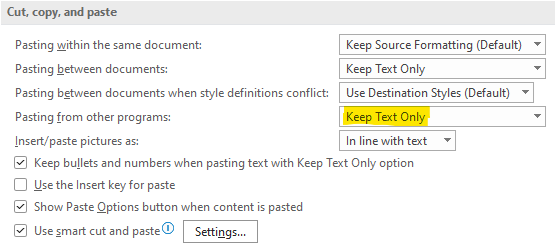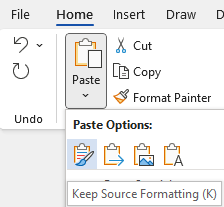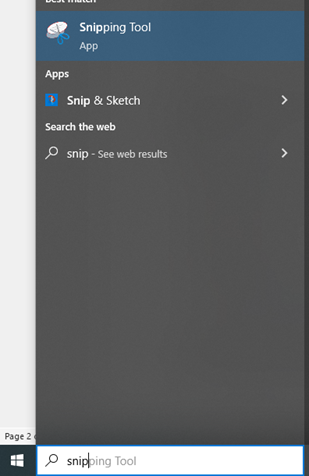This week Viola Henning shares tips and tricks that she’s learned on her own and from others that make creating and editing reports much, much easier. Thanks, Viola! ~Helen
One way to make my day is to show me a cool tip or trick on the computer that’s going to make my work life easier. Some of these are ones you may already know (if so, great!), but I hope there will be at least one or two that will be new and helpful to you.
If you have two monitors, then you know how much time it can save you. I actually don’t (my preference is to just have everything on one screen), so I love to Alt + Tab to switch between programs. If I need to compare things side by side, I use Windows Logo Key + Right or Left Arrow (The arrow determines which side of the screen it will be on).
Text-only copy-and-paste
One of the things that has saved me the most time is setting Word to Keep Text Only when Pasting from other programs. You can get to this by going to File > Options > Advanced and then scrolling down to this:
If I do want to keep the formatting from a website or other program I’m pasting from, then I can just go to the Paste drop-down and select Keep Source Formatting. (This is accessible by right-clicking as well).
Some other tips for How to Strip Formatting When You Copy and Paste Text include Ctrl + Shift + V (Cmd + Shift + V on Mac).
Also, Chrome has a browser extension called Copy As Plain Text that enables you to highlight the text you want on a webpage, then right click and choose Copy as Plain Text to strip the formatting out before you paste it. At least one other browser has a similar extension.
Keyboard Shortcuts
Keyboard shortcuts such as Ctrl + C and Ctrl + V can be huge timesavers. Windows logo key + D displays and hides the desktop, as does the vertical bar all the way over in the bottom right of the screen.
Keyboard shortcuts in Word include:
| Keyboard shortcut | What it does |
| Shift + F3 | switches the case of the selected text between upper case, lower case, and title case |
| Ctrl + Home | moves the cursor to the beginning of the document (See Navigate the document for other such shortcuts) |
| Ctrl + End | moves the cursor to the end of the document (See Navigate the document for other such shortcuts) |
| Ctrl + Backspace | deletes one word to the left |
| Ctrl + Delete | deletes one word to the right |
If you want to take it a step further, you can actually create your own keyboard shortcuts for commands you frequently do.
You can also add a frequently used command or commands to your Quick Access Toolbar at the top of Word or otherwise customize the Quick Access Toolbar. You can press Alt and a number to execute any of your Quick Access Toolbar commands.
Another great tip from my colleague Rick Snyder is that you can make changes to AutoCorrect (e.g., add a word or phrase that you often misspell). A great example from him is 501(c)(3). If you add that to AutoCorrect, then you never have to worry about Word autocorrecting it the wrong way.
The days of using two spaces after a period are over (I know, I’m still getting used to it, too). To make it easier to spot spacing mistakes, you may want to click the Show/Hide button to turn on hidden characters like spaces, paragraph markers, or tab marks. Or, just use Replace (Ctrl + H) to swap a period followed by two spaces for a period followed by one.
Adding images
I’m very visual so I love to add images. Rather than clicking the Prt Sc (Print Screen) key, pasting into a program like Paint and then selecting the portion of the image I want to copy into Word or another document, I can do all this in one step by using the Snipping Tool to capture images. You can get to it by typing “snip” in the search box in the bottom left of your screen.
Or, even faster, a tip straight from Helen Brown, you can just hit Windows Logo Key + Shift + S. If you open the Snipping Tool app and click the New button then select the portion of screen you want to capture (or click on the pop-up that will appear in the bottom right of your screen right after you select the image you want to capture using Windows Logo Key + Shift + S), you get some options for making adjustments to the image (e.g., highlighting) and you also have the option of saving the image. If you don’t need any of that, you can just select your image and paste it right into Word, an email or wherever you need it. (Once you select the image, it will be copied right to your clipboard).
Speaking of the clipboard, you can turn on your clipboard history and press Windows Logo Key + V to be able to see the most recent things you’ve copied and be able to paste and pin things you frequently copy.
A mouse with a forward and back browser button and good scroll wheel can also be a big help.
Thank you to Rick Snyder, Cap Henning, Nicole Dehaven, Eli Mendelson, Christina Bailey, Helen Brown, Kenny Tavares and all of the helpful people who have made my day by showing me one or more of these tricks or one like it.






